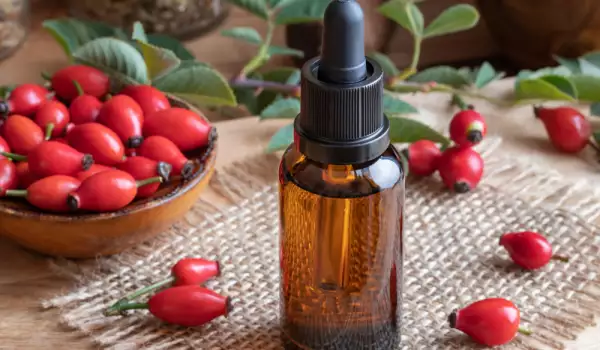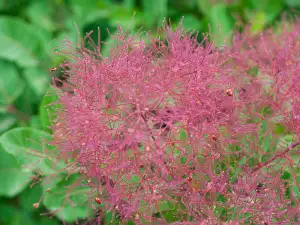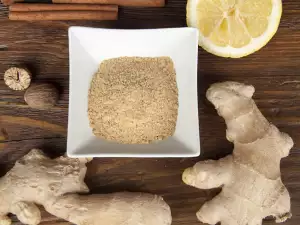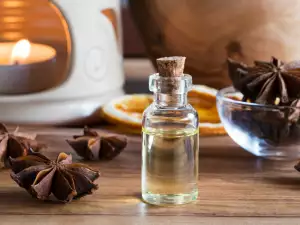Rosehip is a modest shrub of the Rosaceae family, distributed in the temperate and subtropical regions of the Northern Hemisphere. About 400 species are known from this shrub and some of them grow only in one place and nowhere else.
Essential oil is extracted from this interesting plant.
It is a remarkable fact that the petals of the same rosehip contain a large amount of essential oil, which has incredibly diverse medicinal properties and hence diverse applications. Here's what they are.
General description of rosehip essential oil
Rosehip oil is considered the fountain of youth, and this is a well-deserved definition, giving rosehip essential oil the role of one of the most effective base oils widely used in cosmetics. It restores the radiance of the skin, prevents aging and has a powerful regenerating effect.
Rosehip oil is an outstanding popular vegetable oil in aromatherapy with numerous benefits for the skin. It achieves a lightening effect and removes skin imperfections, restores the natural color and tone of the skin. The content of many vitamins, antioxidants and essential fatty acids deeply nourishes the skin and does wonders for it. It removes scars, accelerates cell regeneration, facilitates the healing of wounds and burns and soothes dryness and inflammation.
The most valuable is cold-pressed rosehip base oil, which is obtained from the plant and contains the maximum amount of useful substances of the rosehip bush.
Quality rosehip oil is a key ingredient in creams, lotions, massage oils, face serums and body oils.
It is used in cosmetics so widely because it is suitable for all skin types, including sensitive, dry, scarred and blemished or UV-damaged skin.
Obtaining rosehip essential oil

Rosehip oil is usually extracted from the seeds and fruit of the wild rosehip by cold pressing.
In order to obtain cold-pressed oil, the fruit are separated from the rosehip bush. They are heat treated in water to allow the seeds to rise to the surface. The seeds are then extracted from the mixture using a sieving process. After drying, they are ready for oil extraction. This is done by cold pressing, similar to the process for other essential oils.
In addition to the origin, the quality of the oil is also guaranteed by its color. It is orange, but the concentration of essential fatty acids and beta-carotene can also cause significant changes in shade or overall color. Pure, high-quality, cold-pressed rosehip seed oil is reddish-orange or deep golden in color.
Chemical composition and beneficial properties of rosehip essential oil

The main ingredients of rosehip oil are: linoleic acid, linolenic acid, oleic acid, palmitic acid and stearic acid. In addition, its content includes vitamins A, C, E, F and carotenoids, which are known because they are responsible for its orange color.
Linoleic acid, omega 6 - useful properties:
- Moisturizes the hair and retains moisture in it, thus promoting its growth;
- Supports wound healing;
- Appears as an emulsifier in the preparation of soaps and quick-drying oils;
- Has anti-inflammatory properties;
- Soothes acne irritation and eliminates the risk of new pus foci on the skin;
- Promotes the retention of moisture in the skin and hair;
- Used in various oil blends.
Alpha-linoleic acid, omega-6 - beneficial properties:
- Reduces inflammation;
- Controls blood clotting in the skin layer;
- Soothes joint pain and relieves stiffness.
Oleic acid, omega 9 - beneficial properties:
- Maintains the softness, elasticity and shine of the skin and hair;
- Stimulates hair growth, makes it stronger and shinier;
- Reduces the appearance of spots, wrinkles and fine lines;
- Removes dandruff, thus supporting hair growth;
- Increases immunity;
- It has an antioxidant effect;
- Prevents joint inflammation, stiffness and pain.
Palmitic acid - useful properties:
- Has a softening effect;
- Nourishes the hair without leaving greasy residues;
- The most common saturated fatty acid.
Stearic acid - useful properties
- Has a cleansing effect, removes dirt, sweat and excess sebum from hair and skin;
- An ideal emulsifier that binds water and oil;
- Maintains and protects the hair without reducing its shine;
- Softens the skin.
Benefits of using rosehip oil

Rosehip seed oil is known for its anti-aging properties and is therefore often included in natural products for mature skin. It accelerates the skin's regenerative processes and reduces the appearance of unwanted skin conditions, such as pigmentation and scars.
The oil is effective for u soothing skin affected by dryness, eczema or even psoriasis. Restores elasticity, fights wrinkles and stretch marks on it. Creates a protective barrier on the skin that prevents its dehydration.
The fatty acids of rosehip oil reduce the itching characteristic of dry scalp. Rosehip oil immediately restores the hair's shine by eliminating dandruff, making it easy to use directly on the scalp without causing the hair to become greasy. Vitamin-rich rosehip oil provides hair elasticity, makes it more voluminous, healthy and shiny.
It strengthens not only the cells and tissues, but also the brittle nails, that is why it is the most used oil to maintain the nails.
Rosehip oil for hair
Rosehip oil can be applied directly to the scalp. It hydrates dry hair and at the same time soothes it, removes and prevents dandruff.
To restore the shine of the hair and nourish it, it is applied mixed with castor oil in equal proportions.
Rosehip oil for nails
Rosehip oil hydrates and strengthens the nails, removes their dryness and brittleness. It can be massaged directly onto the nails using the tips of the fingers or with a cotton swab, without the need to wash off.
During a massage
It is applied to stretch marks, to relieve sunburns and inflammations. Alternatively, rosehip oil can be mixed with essential oils known to reduce the appearance of unwanted dark spots such as tea tree essential oil or lemon essential oil.
For aromatherapy massage, rosehip oil can be mixed with mint, lavender, chamomile or frankincense essential oil.
How to use rosehip oil
Rosehip oil is absorbed into the skin faster than many other oils. It is unlikely to clog facial pores. However, it is recommended not to be used on its own, but always in combination with other oils. It can be used as:
- natural exfoliant for face and body, mixed with honey and sugar;
- as a facial moisturizer that keeps the skin hydrated and elastic;
- to nourish the skin of the face and to soothe irritated skin;
- to remove make-up.
Replacing rosehip oil with other base oils
Since it is not recommended to be used on its own in many cases, rosehip oil can be mixed with other suitable oils. Such are tea tree oil, lavender oil, chamomile oil, frankincense oil, mint oil, lemon oil and others.


















Comments